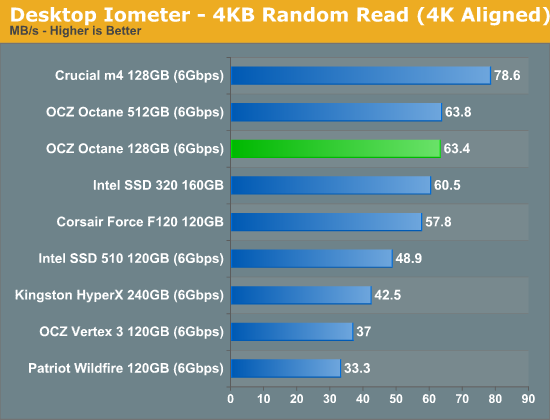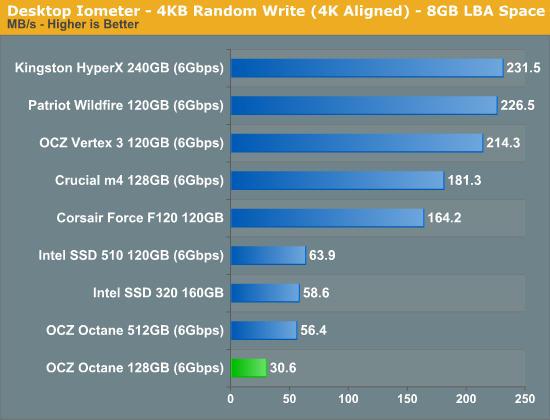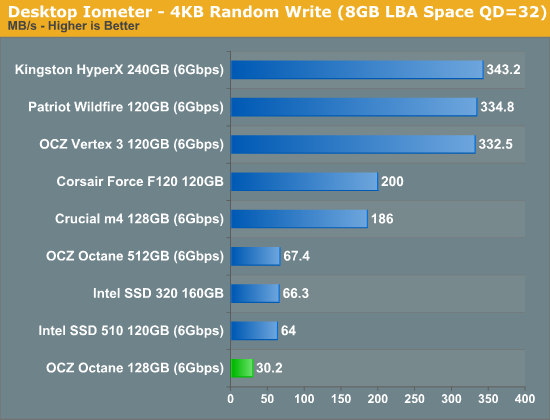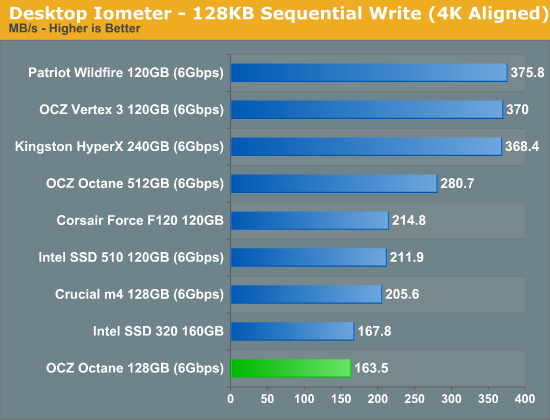OCZ Octane 128GB SSD Review
by Anand Lal Shimpi on December 28, 2011 12:27 AM ESTRandom Read/Write Speed
The four corners of SSD performance are as follows: random read, random write, sequential read and sequential write speed. Random accesses are generally small in size, while sequential accesses tend to be larger and thus we have the four Iometer tests we use in all of our reviews.
Our first test writes 4KB in a completely random pattern over an 8GB space of the drive to simulate the sort of random access that you'd see on an OS drive (even this is more stressful than a normal desktop user would see). I perform three concurrent IOs and run the test for 3 minutes. The results reported are in average MB/s over the entire time. We use both standard pseudo randomly generated data for each write as well as fully random data to show you both the maximum and minimum performance offered by SandForce based drives in these tests. The average performance of SF drives will likely be somewhere in between the two values for each drive you see in the graphs. For an understanding of why this matters, read our original SandForce article.

Random read performance remains untouched with the move to 128GB, although random write performance is cut in half compared to the 512GB version:

Many of you have asked for random write performance at higher queue depths. What I have below is our 4KB random write test performed at a queue depth of 32 instead of 3. While the vast majority of desktop usage models experience queue depths of 0 - 5, higher depths are possible in heavy I/O (and multi-user) workloads:

Sequential Read/Write Speed
To measure sequential performance I ran a 1 minute long 128KB sequential test over the entire span of the drive at a queue depth of 1. The results reported are in average MB/s over the entire test length.

Sequential read performance is once again untouched compared to the larger capacity Octane, while sequential write performance is seriously impacted:











38 Comments
View All Comments
Xpage - Wednesday, December 28, 2011 - link
Thank you for the review on a model that is more down to earth on its cost.JonnyDough - Wednesday, December 28, 2011 - link
I second that. I'm glad you went with a lower capacity model. I wish you had included a first generation Vertex drive, along with a second for scaling. It may be SATA II, but I'm still using Vertex 2 drives and I would like to see just how modern drives compare.Also, it seems to me that the best middle of the road performer here is Patriot's Wildfire drive.
realjetavenger - Wednesday, December 28, 2011 - link
I was thinking the same thing. The Kingston HyperX and Patriot Wildfire are at the top of most of the charts and seem to be the real winners here.harshw - Wednesday, December 28, 2011 - link
Hi AnandWill you be reviewing mSATA SSDs at any point ? It's the same thing with them - limited PCB space meaning 2-4 NAND chips => much less performance. I'm looking to add some mSATA SSDs to my HTPC and laptop, but where the vendors advertise insane performance, the forums tell another story :)
Rick83 - Wednesday, December 28, 2011 - link
A little tip: For small devices go for SLC NAND. That way you still get decent performance (and life-time - with little space there are less replacement blocks, and only so much load-leveling you can do) out of small devices, while only paying about ~2.5x as much - which at the small volumes isn't so dramatic.harshw - Wednesday, December 28, 2011 - link
The cheapest for 20GB SLC mSATA is £100 - that's the Intel 311 series. Is there a 40GB SLC mSATA ? Can't seem to find anyIn any case a Kingston mSATA 60GB with the Phison controller nets for £75 and the OCZ Nocti 60GB with the Sandforce controller is £90~£100. The OCZ Strata 60GB with the Indilinx Eco controller is also around £75 but since there are no reviews and proper tests, can't really figure out which one to buy ...
Rick83 - Saturday, January 7, 2012 - link
Small devices for me are in fact up to 20 GB (I'm running two 8GB SSDs, where MLC might fall short). Above that, there is usually enough space to do decent wear leveling. (Wear is a function of the amount of writes per write block, hence the same amount of data written to a small drive over the same time, means more writes per cell, given the same level of write amplification)It depends on your use case as well - for hybrid-caching or silencing down a HDD by putting the swap file on flash, SLC is probably the better choice, but for portable applications, MLC always wins due to size being more important than performance.
Ammaross - Wednesday, December 28, 2011 - link
They've already benched the Intel mSATA devices. I'd go with MLC simply for cost effective reasons. In a year or two if you even are remotely worried about your NAND life, go buy another drive with the now twice the capacity and half the price.... (btw, NAND lifespan isn't near as important as it used to be. You're far more likely to drop-kick your Atom CPU well before your NAND dies).Samus - Wednesday, December 28, 2011 - link
You are so sexy!Tchamber - Wednesday, December 28, 2011 - link
I liked your comment about how many Velociraptors we could RAID for the price of an SSD. I have two 300gig 'Raptors in my desktop, backed by an i7 970. Funny thing, my Core 2 Quad latop with and Intel SSD 320 120gig feels every bit as snappy, even better when booting or loading PSE. I should put the SSD in my desktop for a day and see what my file transfers would be.